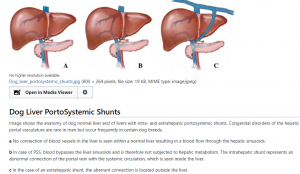6 Liver shunts
Pathophysiology
Blood is supposed to move (1) from the intestines to (2) the liver to (3) the rest of the organs and then (4) to the heart to be oxygenated. In a normal animal, the liver filters out the nutrients and toxins prior to the blood going to the other organs.
In some animals, blood bypasses the liver through “shunts”. These shunts can be outside the liver (extrahepatic) or inside the liver (intrahepatic).

Congenital shunts more commonly affect small breeds (Miniature Schnauzers, Yorkshire terriers, Maltese, Pugs and Cairn terriers).
Animals with congenital liver shunts are not able to use the nutrients from the gut and are often the runts, are small in stature, and/or don’t grow well. Dogs may be otherwise healthy or have vomiting or polyuria/polydipsia. Hepatic encephalopathy can develop from high ammonia levels (no urea cycle) as can ammonium urate stones in the urinary tract. If anesthetized, affected animals may be slow to recover from the drugs. Cats more typically show drooling and seizures. Cats often have copper colored eyes.
Diagnosis
Liver enzymes are often normal or only mildly elevated. Animals may be anemic and demonstrate limited liver production with hypoalbuminemia, low creatine, low blood urea nitrogen, low cholesterol and sometimes low blood glucose.
Serum bile acids are the most useful for testing liver function in these animals and are almost always elevated.
Ammonia levels are typically elevated after eating.
Abdominal ultrasonography can be helpful; CT angiography is considered the gold standard.
Therapy
Surgery is an option for many of these dogs, with the shunt clamped closed slowly over time so new blood supply develops.
Medical treatment includes support as needed eg fluids and gut protectants to prevent ulcers. Reduction of blood ammonia concentrations can be achieved through warm water enemas, dietary protein reduction, lactulose and antibiotic therapy.
Resources
Portosystemic shunts in dogs, VCA
Extrahepatic shunts, UGA free ibook
Portosystemic shunts, K Tobias
Portosystemic shunts, ACVS
Liver shunts, UTenn
Feline shunts– Cornell

